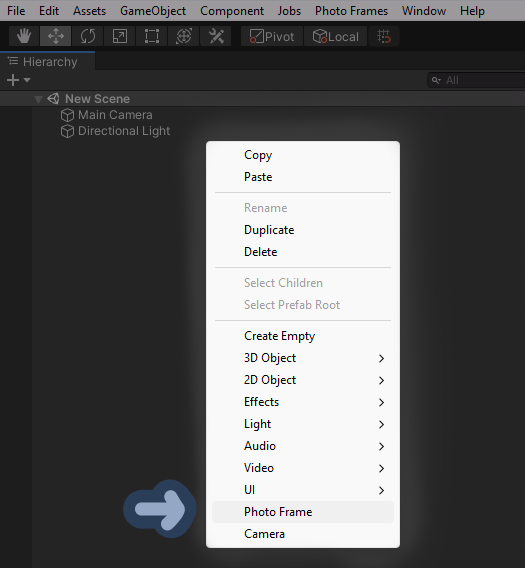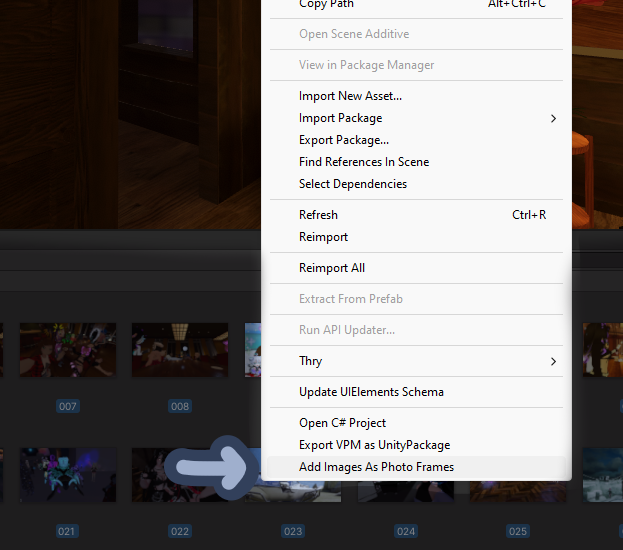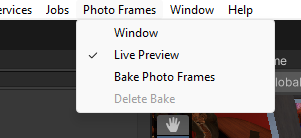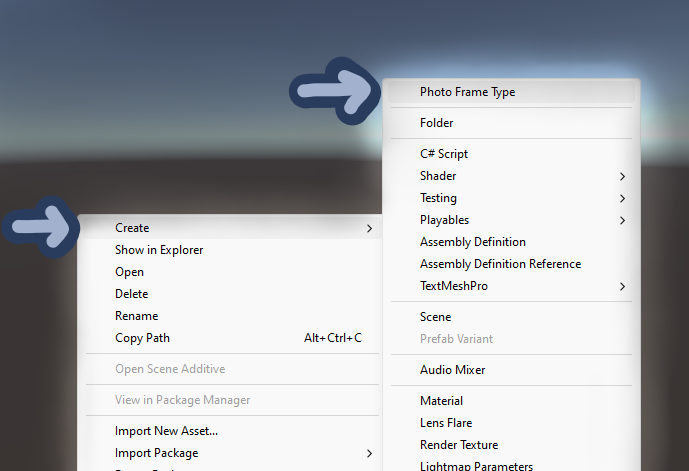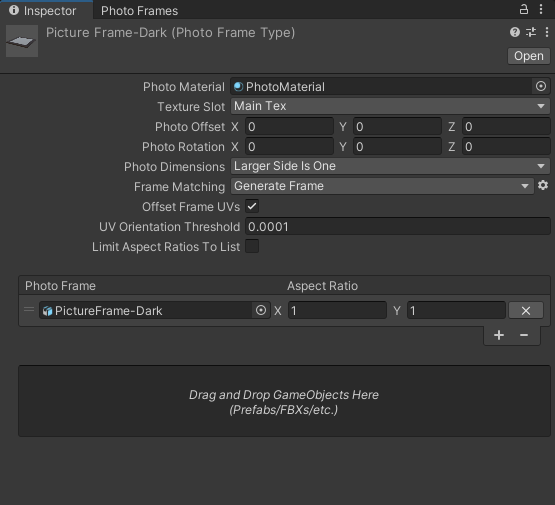Photo Frame Manager
Photo frame manager and optimizer package for Unity. Has photo cropping, scaling, and resizing with live previews in the 3d scene and inspector. Bakes photos to optimized textures which reduce gpu memory usage, lower the material count, and are optimized for mipmap streaming.
Tested for Unity2019, Unity2021, Unity2022, and VRChat. Note that this is an editor only utility that makes and sets up assets for you before you build.
Installing (VRChat Creator Companion)
Have VCC installed first https://vcc.docs.vrchat.com/
Click this Add Photo Frames Manager To VCC
Now in VCC when managing a project the Photo Frame Manager package will apear in the list of available packages
Installing (Unity Only)
Window > Package Manager
Plus button (+) > Add package from git URL...
Paste the url https://github.com/codec-xyz/photo_frame_manager.git?path=/src and click add
Adding Photo Frames
Right click in the Hierachy or click the GameObject menu at the top to open the game object context menu and click Photo Frame to add an empty photo frame to the scene.
Or
you can right click on some image files in the project file view and select Add Images as Photo Frames to add photo frames with the selected images set. You can add many images at once this way.
Photo Frame Settings
Select the photo frame and look in the Inspector to see the settings.
Frame Type - the picture frame set that you want to use (this is a file type this package adds). A picture frame set has multiple of the same looking picture frames but with different aspect ratios. It also sets the material of the photo. Setting this to none will result in just the photo with the default unlit material. More detail on the Photo Frame Type file further down
Photo - the photo you want to use
Auto Select Aspect Ratio - when checked will auto select the best matching aspect ratio based on the frame and photo's aspect ratio
Crop Scale - zooms the crop in
Crop Offset X - move the crop left or right
Crop Offset Y - move the crop up or down
Don't Bake Photo Use Source - does not bake photo. Uses the specified photo as the material texture
Resolution Type - the way the resolution is controlled
- Use Scene Settings
- Resolution Max Major Size - the size in pixels you want for the photo's larger side to be. Acts as an upper limit so if the size is larger than the photo's actual size its resolution stays unchanged. The buttons below are some presets for this value
- Relative - value 0 - 1 that scales the photos full resolution
- Full - resolution stays unchanged. Note if the baked texture size is smaller then the resolution will be lowered to fit
The selected photo is displayed with a grey overlay to show the area being cropped out.
Object Scale - a slider to more easily change the object's scale. The slider is non linear and the max value changes based on the current scale
Snap To Wall - moves the photo frame to the nearest collider behind it
Snap Down - moves the photo frame to the nearest collider below it
All of these settings including the resolution update the photo frame preview in the 3d scene live.
Baking Photo Frames
In order to export your project the photo frames must be baked first. This will sort, pack, and merge the photos into a set of textures and picture frames and photo meshes will be set up.
As a note, for best preformance when baking make sure Jobs > Burst > Enable Compilation is checked. However the largest bottleneck of the baking proccess is unity importing all the created objects.
In the Photo Frames menu you can directly Bake Photo Frames and also delete the baked data.
If you click the Photo Frames > Window that will bring up a window with bake settings, a list of photos in the scene to find specific photos easily, and a list of baked textures with info about each.
These settings are saved directly into the scene file, and all generated assets (materials, meshes, textures) are saved into the "Assets/PhotoFramesAutoGenerated" folder.
Bake Settings
Bake Texture Size - the target size of the baked textures. Some texture might be smaller to reduce size
Photo Margin - extra colored area around photos to prevent texture bleeding; measured in pixels
Scale Photo Margin - Scales the photo margin down when baked textures are below the specified baked texture size
Join Duplicate Photos - Joins duplicate photos in baked texture
Scale Resolution By Size - Scales the resolution of photos based on their scale. Resolution starts being lowered at the maximum value and stops at the minimum value. Photos with resolution full are skipped
Resolution Max Major Size - Photo frames set to "Use Scene Settings" will use this resolution value
Advanced Settings
Texture Fit - sorting prioritization (spacial sorting for better mipmap streaming vs fewer textures)
- 0 - sorted for better mipmap streaming
- 1 - sorted for fewer textures
Estimated Pack Efficiency - Expected packing efficiency used when sorting
A link to the paper about the packing algorithm used is linked below.
Skyline Max Spread - a parameter to the pack algorithm
Overhang Weight - a parameter to the pack algorithm
Neighborhood Waste Weight - a parameter to the pack algorithm
Top Waste Weight - a parameter to the pack algorithm
Texture Settings
These are named the same as Unity's texture import settings. The docs are found here https://docs.unity3d.com/Manual/class-TextureImporter.html
These are all the photos present in the scene. Clicking a photo will select and highlight that photo frame in the scene.
These are all the baked textures currently saved and some information about each. Clicking a photo will select and highlight that photo frame in the scene.
Photo Frame Type Files
Some fully setup picture frames are included with this package.
These files define picture frames. They are a set of picture frames that should look the same but have different aspect ratios. They also hold a material that gets copied and used for the photo and other settings.
If you want to setup your own bring the model(s) into unity in any format that can be drop directly into a scene for example: .fbx, .obj, .blend, .prefabs, etc. Then right click in the project file view > Create > Photo Frame Type
Select the file and look in the Inspector to see the settings.
Photo Material - the material that gets copied and used for the photo. All values in the material are kept. Leaving this blank will result in the photo using the default unlit material
Texture Slot - list of slots to use on the photo's material (In preview mode some textures like normal textures do not get enabled by Unity unless that texture is set in the source material. This does not effect baked photos)
Photo Offset - photo offset for frame
Photo Rotation - photo rotation for frame
Photo Dimensions - setting for sizing the photo inserted into frame
Frame Matching - settings for automatically resizing frame to fit photo
- None
- Scale To Photo
- Generate Frame - algorithm to resize frame mesh to different aspect ratio
The rest is a list of the picture frame file and its aspect ratio. The order does not matter except that the first object in the list is used as the preview. Leaving the list blank is okay and will result in no picture frames. This can be used to set just the material of a photo.
The box at the bottom can be used to drag and drop one or more GameObject files into the list. This will also try to get the aspect ratios from the file names.
UI Alignment
If you don't like the right aligned fields you can turn them off in Window Manger > Gear icon in the top right > Right Aligned Fields
Untracked Assets
When running Delete Bake only known and tracked assets are deleted. If for what ever reason assets are created but lost track of, like in the case of a crash during a bake or bug in the code, then they will not be deleted. All created assets are placed in "Assets/PhotoFramesAutoGenerated" and all files in that folder are safe to delete and can be completely regenerated.
Performance And Memory Improvements
This unity package improves the performance and memory usage compared to having seperate textures and materials per photo and does all this with a single click. Simplicity and ease of use is very important.
The baking process has a purpose built sorting step that places physicaly close photos in the same textures. This aides the mipmap streaming process since far away photos are grouped into their own textures and the full resolution texture does not need to be kept in vram thus reducing vram usage. Mipmap streaming is a process handled by unity and the baked textures are set up for mipmap streaming automatically when you bake photo frames.
As a note moving around the photo frames a lot during runtime could make the mipmap streaming less effective. In such a case the Texture Fit bake setting can be set to 1 to prioritize fewer textures over mipmap streaming optimization.
The photos are also packed and merged. GPUs generally require square and power of 2 (...1024, 2048, 4096...) textures and textures that do not match are wastefully made to fit. Photos are often not power of 2 and not square, so packing many photos in square power of 2 texture helps to reduce vram usage. Multiple photos sharing a single texture also means fewer materials are required thus reducing draw calls and improving performance.
Attributions
Ambient CG - https://ambientcg.com/
Packing algorithm in this package is based on... - https://www.researchgate.net/publication/221049934





